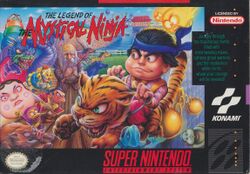
| The Legend of the Mystical Ninja | |
|---|---|
| Developer(s) | Konami |
| Publisher(s) | Konami |
| Year released | 1991 |
| System(s) | SNES, Game Boy Advance, Wii, Wii U, New Nintendo 3DS |
| Preceded by | Ganbare Goemon Gaiden: Kieta Ougon Kiseru |
| Followed by | Ganbare Goemon: Sarawareta Ebisumaru |
| Series | Legend of the Mystical Ninja |
| Genre(s) | Action-adventure |
|---|---|
| Modes | Single player, Co-op |
| Rating(s) |
The Legend of the Mystical Ninja (がんばれゴエモン〜ゆき姫救出絵巻〜 Ganbare Goemon: Yukihime Kyuushutsu Emaki?), is a light-hearted action-adventure game for 1-2 players by Konami, and was released for the Super NES in June of 1992. It was later released in Europe in 1994. It was also ported to the Game Boy Advance along with Ganbare Goemon 2: Kiteretsu Shougun Magginesu only in Japan. It is the first game in the Japanese video game series Ganbare Goemon to have a western release. It has also been released for the Wii Virtual Console and the Wii U Virtual Console in Japan, Europe, and North America. The game was also one of the 21 games to be included on the Japanese Super Famicom Mini.
-
Japanese box
Story[edit]
After noticing some odd occurrences in their hometown of O-Edo, Goemon and Ebisumaru decide to investigate. After defeating the evil Ghost Woman in Horo Temple, they soon discover through the words of a ninja cat, that Yuki-Hime (Princess Yuki) has been kidnapped by the Otafu Army. To save the princess and the entirety of their town, the protagonists must travel through different regions of Japan to find clues about the terriorists and the location of the princess, while meeting some real wacky characters. During their journey, the two heroes meet the Wise Old Man of Iga, who uses a transportation device to help the two get to the Princess faster. However, the machine fails and the two have to walk the rest of the way. Once they finally reunite Yuki with her father, the O-Edo Lord, it is revealed that the shoguns were disguised as the O-Edo Lord and his servants. Goemon and Ebisumaru are then thrown in the dungeon. With the help of their friend, Yae, the heroes escape the cell and climb to the top of the castle to stop the army once and for all and save Yuki-Hime.
Regional Differences[edit]
Legend of the Mystical Ninja, like many games from Japan, went through many regional changes when being "western-ized" for North America and Europe. While the games Japanese theme was left intact, many items in the game were not. Onigiri is a food made of rice, wrapped in seaweed and shaped in different forms. These foods can be bought from shops in the Japanese version. Since Onigiri wasn't known in the west, it was changed to Pizza, a more traditional food in the west. The names of the main characters were also changed. Goemon became Kid Ying and Ebisumaru became Dr. Yang. There also some censorship that was made to the game. This involves two scenes that you can watch for $100. One of the scenes, involves Ebisumaru dancing and eventually farting at the end. This scene was removed most likely because Ebisumaru pulls his pants down at the end. However, the game's instruction manual, Nintendo Power article and it's section in the Prima's Super NES Secrets Volume 2 book, prove that this event was cut late in development, after sending the game to publications for review. The second scene was where a Japanese lady preforms a strip tease. This scene was obviously removed from the U.S version due to Nintendo's strict policies. The PAL version (released later in 1994) is the same as the U.S release with a slower frame rate due to it being a PAL game. However, Europe also received a complete German translation of the game exclusive to Germany (what a shock).
Table of Contents
- Ganbare Goemon! Karakuri Douchuu
- Ganbare Goemon 2
- Ganbare Goemon Gaiden: Kieta Ougon Kiseru
- The Legend of the Mystical Ninja
- Ganbare Goemon Gaiden 2: Tenka no Zaihou
- Ganbare Goemon 2: Kiteretsu Shougun Magginesu
- Ganbare Goemon 3: Shishijuurokubee no Karakuri Manji Gatame
- Ganbare Goemon Kirakira Douchuu: Boku ga Dancer ni Natta Wake
- Soreyuke Ebisumaru Karakuri Meiro: Kieta Goemon no Nazo!!
- Mystical Ninja Starring Goemon
- Goemon's Great Adventure
- Goemon Mononoke Sugoroku
